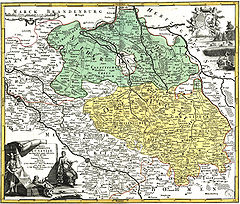- Lower Lusatia
-
 Coat of arms of Lower Lusatia, Hugo Gerhard Ströhl
Coat of arms of Lower Lusatia, Hugo Gerhard Ströhl
Lower Lusatia (German: Niederlausitz, Lower Sorbian: Dolna Łužyca, Upper Sorbian: Delnja Łužica, Czech: Dolní Lužice, Polish: Łużyce Dolne) is a historical region stretching from the southeast of the Brandenburg state of Germany to the southwest of the Lubusz Voivodeship in Poland. Important towns beside the historic capital Lübben include Calau, Cottbus, Guben (Gubin), Luckau, Spremberg, Finsterwalde, Senftenberg and Żary. Lower Lusatia is a settlement area of the Sorbs whose endangered Lower Sorbian language, a West Slavic language is related to Upper Sorbian and Polish.
Geography
The area within the North German plain is characterised by forests and meadows. Between Lower Lusatia and the southern Upper Lusatia is a hill region called Grenzwall, meaning "border dyke", the eastern continuation of the Fläming Heath. In the Middle Ages this area had dense forests, so it represented a major obstacle to civilian and military traffic. In the glacial valley south of it the Spree river branches out into the Spreewald wetlands.
In the course of much of the 19th and the entire 20th century, it was shaped by the lignite industry and extensive open-pit mining by which several of the region's villages were damaged or destroyed especially by order of East German authorities. While this process is still going on, some now exhausted former open-pit mines are being converted into artificial lakes, with much hope to attract vacationers, and the area is now being referred to as Lausitzer Seenland ("Lusatian Lakeland").
History
The area of Lower Lusatia roughly corresponds with the former March of Lusatia or Saxon Eastern March between the Saale and Bóbr rivers, which about 965 was severed from the vast Marca Geronis, conquered by the Saxon count Gero in the course of his campaigns against the Polabian Slavs from 939 on. Odo I became the first margrave, his successor Gero II from 1002 on had to face several attacks by Polish duke Bolesław I Chrobry, which did not end until the 1018 Treaty of Bautzen ceding large parts of eastern Lusatia to Poland. Emperor Conrad II reconquered the territories in 1031.
 Lower (green) and Upper Lusatia (yellow), Johann Homann, early 18th century
Lower (green) and Upper Lusatia (yellow), Johann Homann, early 18th century
In 1136 Conrad the Great from he mighty House of Wettin, margrave of Meissen since 1123, also received the March of Lusatia in 1136. It remained under the rule of the Wettin dynasty until in 1303 the Lusatian march was acquired by the Ascanian margraves of Brandenburg. With Brandenburg the march was inherited by the House of Wittelsbach in 1320, Elector Otto V in 1367 finally sold it to Emperor Charles IV of Luxembourg who incorporated Lower Lusatia into the Lands of the Bohemian Crown. Charles father King John of Bohemia had already acquired the adjacent territory to the south around Bautzen and Görlitz, for which the terminus Upper Lusatia came into use. The former Lordship of Cottbus was acquired by Brandenburg in 1455 and remained an exclave in the Bohemian kingdom.
Both Lusatias formed separate Bohemian crown lands under the rule of the Luxembourg, Jagiellon and - from 1526 - Habsburg dynasties. In the course of the Reformation the vast majority of the population turned Protestant. The Bohemian era came to an end when Emperor Ferdinand II of Habsburg ceded the Lusatias to Elector John George I of Saxony by the 1635 Peace of Prague in return for his support in the Thirty Years' War, whereby the lands returned to the House of Wettin. As the Kingdom of Saxony had sided with Napoleon it had to cede Lower Lusatia to Prussia in the 1815 Congress of Vienna, whereafter the territory became part of the Province of Brandenburg. With the implementation of the Oder-Neisse line by the 1945 Potsdam Conference, the lands east of the Neisse river fell to Poland.
Nature reserves and parks
- Spreewald
- Lausitzer Seenland
- Niederlausitzer Heidelandschaft Nature Park
Categories:- Geography of Lusatia
- Historical regions in Germany
- Geography of Brandenburg
- Historical regions in Poland
- Sorbian people
- Regions of Saxony
- Former duchies of the Kingdom of Bohemia
Wikimedia Foundation. 2010.

